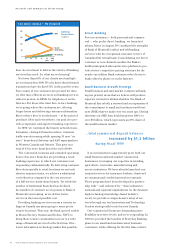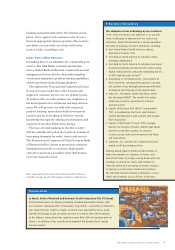Bank of Montreal 1999 Annual Report Download - page 20
Download and view the complete annual report
Please find page 20 of the 1999 Bank of Montreal annual report below. You can navigate through the pages in the report by either clicking on the pages listed below, or by using the keyword search tool below to find specific information within the annual report.
18 Bank of Montreal Group of Companies 1999 Annual Report
Our employee strategy has three compo-
nents: attracting and retaining top talent,
creating the conditions to foster and
sustain a highly effective workplace with
above-average performance, and inspiring
a high level of employee commitment.
The way we are increasing the effec-
tiveness of our people is through a pro-
gram called Shifting the Performance
Curve. This program is made up of ten
levers that, according to research, if fol-
lowed in a coordinated fashion and
aligned to specific business needs, should
enhance managerial capabilities and
provide the Bank with a high-value work-
force. Under this strategy we have
focused
on the following key levers in 1999:
Recruiting Those Who Best
Fit the Bank’s Performance
Expectations
A Bank of Montreal Internet recruitment
site was launched at www.bmo.com.
In its first month, this human resources
site had 43,329 visits.
Also this year, an enterprise-wide
university recruitment program was
launched which attracted responses from
more than 8,000 students.
Developing High-Potential
Talent and Closing the Skill Gap
As an organization dedicated to lifelong
learning, the Bank provides oppor-
tunities and facilities for the acquisition
of knowledge and the enhancement
of employees’ skills. In 1999, the Bank’s
Institute for Learning in Scarborough,
Ontario hosted more than 10,000 par
ti-
cipants, providing more than 28,000
training days. More than 50% of
train-
ing at the IFL in 1999 focused on
leader-
ship and management development.
At Bank of Montreal, we believe that people are the key differentiating
factor in determining our success. Employees and customer satisfaction
are inextricably linked. Talented people lead to satisfied and loyal
clients, which increases our share of profitable business.
Our Workforce
In addition, 80% of the Bank’s total
training activities were undertaken at or
near the workplace, delivered through
a wide variety of media.
The focus in 1999 has been on the
development of high-potential man-
agers within the Bank. To further support
the quality of the talent pool, Bank
of Montreal partnered with Dalhousie
University and the Institute of Canadian
Bankers to create an MBA (Financial
Services) for high-potential managers.
This is the first of its kind in North
America and is designed to help finan-
cial services professionals enhance
their managerial and analytical abilities
without taking a leave of absence from
their work. This program has an enroll-
ment of 143, and the first 33 graduates
–
the Class of ’99
–
received their degrees
in Halifax, Nova Scotia in October 1999.
Developing Outstanding Managers
We know that the manager/leader is
critical to both the effectiveness and the
commitment of talented individuals, and
so we focus much of our attention on
developing outstanding managers and
equipping them with the authority, tools
and support they need.
This year we created and implemented
the Managerial Leadership Program, an
initiative designed to identify and develop
outstanding managers. Introduced as
a pilot program, it has already graduated
approximately 200 participants. By the
end of 2001, more than 4,000 of the Bank’s
leaders will have completed the Man-
agerial Leadership Program.
Building Employee Commitment
Attracting talented individuals is only
the first step in winning the war for talent
in any business. Retaining employees
through a combination of reward, envi-
ronment and diversity is a subsequent
and important opportunity for achiev
ing
the high-performance organization.
In response to employee and share-
holder needs, the Bank has created
several new programs to improve our
competitive edge.
By changing the proportion of fixed
and variable costs in its compensation
program, the Bank has strengthened
the relationship between business per-
formance and pay for all employees.
Between 1995 and 1999 the percentage
of total compensation accounted for
by variable pay has more than doubled,
from 12% to nearly 25%.
Flexible benefit programs provide an
emphasis on individual choice and
responsibility. While improving the man-
agement of the fixed/variable costs
through an employer/employee shared
cost model, employees have greater
choice and control of their specific bene-
fit needs.
Ownership and Responsibility
In support of the Bank’s commitment
to maximizing shareholder value,
an Employee Share Ownership Plan was
also introduced in 1999. This plan is
based on an employer/employee contri-
bution matching system. In the pro-
gram’s first five months there has already
been 55% employee participation.
As owners of Bank of Montreal, our
employees have a vested interest
in creating a talented, cost-effective
and committed organization.
Equal Opportunities to
Advance, Grow and Succeed
This commitment is especially expressed
in our progress toward creating a diverse
workforce and a working environment
where every employee has the opportu-
nity to advance, grow and succeed.
We have made a public commitment to
achieve gender balance in the Bank’s
workforce at senior levels by 2007. Since
1992, the representation of women in
executive positions has increased from
9. 3%
to 26.7%. The representation of
Aboriginal
people in our workforce has
increased from 0.5% to 2.2%, the high-
est of any
Canadian bank. As well, the
proportion
of visible minorities in our
Canadian workforce is 17.7%, exceeding
the level in the external workforce. Our
strategies to increase the employment of
people with disabilities in our workplace
continue to show results.
First-ever financial services MBA
























